Eliza Knight's Blog, page 21
August 5, 2015
August 3rd thru August 9th
What Happened This Week in History?
August 3, 1933- Mickey Mouse Watch was introduced for the price of $2.75August 4, 1979- Ramones's "Rock & Roll High School" film premiered in New York, NYAugust 5, 1833- The village of Chicago was incorporated. The population was approximately 250.August 6, 1996- NASA announced the discovery of evidence of primitive life on MarsAugust 7, 1782- George Washington created the Order of the Purple HeartAugust 8, 1899- The refrigerator was patented by A.T. MarshallAugust 9, 1859- Donald Duck received the 2,257th star on the Hollywood Walk of Fame

August 3, 1933- Mickey Mouse Watch was introduced for the price of $2.75August 4, 1979- Ramones's "Rock & Roll High School" film premiered in New York, NYAugust 5, 1833- The village of Chicago was incorporated. The population was approximately 250.August 6, 1996- NASA announced the discovery of evidence of primitive life on MarsAugust 7, 1782- George Washington created the Order of the Purple HeartAugust 8, 1899- The refrigerator was patented by A.T. MarshallAugust 9, 1859- Donald Duck received the 2,257th star on the Hollywood Walk of Fame

Published on August 05, 2015 21:00
August 3, 2015
A Castle Unlike Any Other by Kathleen Bittner Roth
Welcome back to History Undressed, our regular 1st Tuesday of the month blogger, Kathleen Bittner Roth! Today she's talking one of my favorite topics! Castles! Enjoy!
A CASTLE UNLIKE ANY OTHERby Kathleen Bittner Roth

Wandering throughout castles has always been a favorite pastime of mine, from the grand baroque castles of Germany to Empress Elizabeth’s smaller summer palace in Hungary (her favorite). Then there is the beautiful castle in the Scottish Highlands where I was married, complete with bagpipes and handsome kilted Scots.

Of the many castles I have toured in several countries, I find one particular stronghold in Slovenia most intriguing. Not only is the structure unique, but so is its history.Predjama Castle (pronounced pred yom a) is an impregnable fortress extending beyond the visible structure and far into a huge cave on a rocky vertical cliff. The structure was built around the 1200’s by the Lueggs, a noble family who were also known as the Knights of Adelsburg.Around the fifteenth century, along came Knight Erazem Luegger, a rascally robber baron and son of the Imperial Governor of Trieste, Italy (Trieste is only about thirty miles from the castle). After ticking off not only the Hapsburgs for killing one of their leaders, Erazem had the Holy Roman Emperor after him. Deciding his life might be in jeopardy, Erazem hightailed it to Predjama, aligned himself with the Hungarian king and began sacking any Hapsburg estates he lay hands on. Now the Austrians were hopping mad and placed a bounty on him. Erazem and the castle came under siege, but he and his small army only laughed because the fortress was impregnable. They would taunt their would-be attackers by pelting them with cherries. If the invaders wandered too close, they’d receive a rain of hot oil. Erazem spent a year and a day sequestered there. He used a secret passage that led to the back and top of the cliff where he’d slip into a small village and gather supplies.

As bad luck would have it, there was only one place in the entire castle which was not impregnable and where he could become a target—his privy. It hung outward from the castle walls. A servant, having been bribed, lit a candle in a lower floor window signaling that the knight was indeed on his potty throne. The liege of men below, squinting up at that round hole at the bottom of the privy, aimed at the lily-white behind, and with a single cannon-shot sent the robber baron knight to kingdom come.

If you ever travel as far as lovely Slovenia, you won’t want to miss this intriguing landmark. To get there, you’ll enter a verdant, seemingly timeless valley that is at once peaceful. Along the foot path leading to Predjama Castle you’ll find a small but delightful restaurant serving delicious local food. The deck alone is worth the stop for its breathtaking views of the imposing castle and surrounding rolling, green hills.

And only twenty-three miles from Predjama Castle you’ll find the Lipica Stud Farm, cradle for the famous Lipizzaner horses of the Viennese classical riding school since the 1500's. But that’s another story for another time.

Kathleen Bittner Roth thrives on creating passionate stories featuring characters who are forced to draw on their strength of spirit to overcome adversity and find unending love. Her own fairy tale wedding in a Scottish castle led her to her current residence in Budapest, Hungary, considered one of Europe’s most romantic cities. However, she still keeps one boot firmly in Texas and the other in her home state of Minnesota. A member of Romance Writers of America®, she was a finalist in the prestigious Golden Heart® contest. Find Kathleen on Facebook, Goodreads, Twitter, Pinterest and www.kathleenbittnerroth.com.


Check out Kathleen's list of books on Amazon!
A CASTLE UNLIKE ANY OTHERby Kathleen Bittner Roth

Wandering throughout castles has always been a favorite pastime of mine, from the grand baroque castles of Germany to Empress Elizabeth’s smaller summer palace in Hungary (her favorite). Then there is the beautiful castle in the Scottish Highlands where I was married, complete with bagpipes and handsome kilted Scots.

Of the many castles I have toured in several countries, I find one particular stronghold in Slovenia most intriguing. Not only is the structure unique, but so is its history.Predjama Castle (pronounced pred yom a) is an impregnable fortress extending beyond the visible structure and far into a huge cave on a rocky vertical cliff. The structure was built around the 1200’s by the Lueggs, a noble family who were also known as the Knights of Adelsburg.Around the fifteenth century, along came Knight Erazem Luegger, a rascally robber baron and son of the Imperial Governor of Trieste, Italy (Trieste is only about thirty miles from the castle). After ticking off not only the Hapsburgs for killing one of their leaders, Erazem had the Holy Roman Emperor after him. Deciding his life might be in jeopardy, Erazem hightailed it to Predjama, aligned himself with the Hungarian king and began sacking any Hapsburg estates he lay hands on. Now the Austrians were hopping mad and placed a bounty on him. Erazem and the castle came under siege, but he and his small army only laughed because the fortress was impregnable. They would taunt their would-be attackers by pelting them with cherries. If the invaders wandered too close, they’d receive a rain of hot oil. Erazem spent a year and a day sequestered there. He used a secret passage that led to the back and top of the cliff where he’d slip into a small village and gather supplies.

As bad luck would have it, there was only one place in the entire castle which was not impregnable and where he could become a target—his privy. It hung outward from the castle walls. A servant, having been bribed, lit a candle in a lower floor window signaling that the knight was indeed on his potty throne. The liege of men below, squinting up at that round hole at the bottom of the privy, aimed at the lily-white behind, and with a single cannon-shot sent the robber baron knight to kingdom come.

If you ever travel as far as lovely Slovenia, you won’t want to miss this intriguing landmark. To get there, you’ll enter a verdant, seemingly timeless valley that is at once peaceful. Along the foot path leading to Predjama Castle you’ll find a small but delightful restaurant serving delicious local food. The deck alone is worth the stop for its breathtaking views of the imposing castle and surrounding rolling, green hills.

And only twenty-three miles from Predjama Castle you’ll find the Lipica Stud Farm, cradle for the famous Lipizzaner horses of the Viennese classical riding school since the 1500's. But that’s another story for another time.

Kathleen Bittner Roth thrives on creating passionate stories featuring characters who are forced to draw on their strength of spirit to overcome adversity and find unending love. Her own fairy tale wedding in a Scottish castle led her to her current residence in Budapest, Hungary, considered one of Europe’s most romantic cities. However, she still keeps one boot firmly in Texas and the other in her home state of Minnesota. A member of Romance Writers of America®, she was a finalist in the prestigious Golden Heart® contest. Find Kathleen on Facebook, Goodreads, Twitter, Pinterest and www.kathleenbittnerroth.com.



Check out Kathleen's list of books on Amazon!
Published on August 03, 2015 21:00
August 2, 2015
Video of the Week-Strange Historical Facts
Strange facts about history that we didn't learn in school! Believe it or not?
Published on August 02, 2015 21:00
July 30, 2015
Words in History
Then and Now: Word Definitionsevilthen: uppitynow: malevolent and immoralfizzlethen: act of producing quiet flatulencenow: failing at thingscellthen: jailnow: phoneslythen: skillful, clevernow: sneaky and deceitfulfathomthen: to encircle with one's armsnow: to understand after much thought
Erotic Word of the Week
nipplestrawberriescoat hangersbuttonskitten's nosesnums
Erotic Word of the Week
nipplestrawberriescoat hangersbuttonskitten's nosesnums
Published on July 30, 2015 21:00
July 29, 2015
July 27th thru August 2nd
What Happened This Week in History?
July 27, 1940- Bugs Bunny debuts in "Wild Hare"
July 28, 1586- The first potato arrives in BritainJuly 29, 1928- "Walt Disney's ""Steamboat Willie"" is released"July 30, 1729- Baltimore, Maryland is foundedJuly 31, 2007- The iTunes Music Store reached 3 billion songs soldAugust 1, 1944- Anne Frank penned her last entry into her diaryAugust 2, 1824- In New York City, 5th Avenue was opened
July 27, 1940- Bugs Bunny debuts in "Wild Hare"

July 28, 1586- The first potato arrives in BritainJuly 29, 1928- "Walt Disney's ""Steamboat Willie"" is released"July 30, 1729- Baltimore, Maryland is foundedJuly 31, 2007- The iTunes Music Store reached 3 billion songs soldAugust 1, 1944- Anne Frank penned her last entry into her diaryAugust 2, 1824- In New York City, 5th Avenue was opened
Published on July 29, 2015 21:00
July 27, 2015
Steampunk Lessons from a Family History on Sawmill Operation ~ Part Two by Laurel Wanrow
History Undressed would like to welcome back guest author, Laurel Wanrow, with Part Two of Lessons from a Family History on Sawmill Operation.

Last week, I introduced my grandfather, Herb Wanrow, and the operation of his steam engine-powered sawmill. To my surprise, according to my aunt, most times Herb would take the sawmill to people.
I’d never heard of a portable sawmill, but understood why Herb moved the operation when she reminded me that back in those times transporting the sawmill was easier than hauling the logs for a building’s worth of lumber to Herb’s farm—and back again! There was one caveat: the location had to have a supply of water. Usually the farmers in the area cut from their timber and dragged the logs with teams of horses or mules to a local water source, then put in a request for Herb to come out.
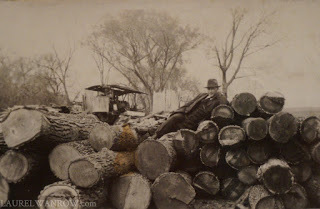
However, I learned ‘easier’ was relative when my aunt relayed this story. Herb and his fireman would set off in the morning with the steam engine pulling the entire rig: sawmill on its wheeled platform, water tank mounted on iron wheels and a wagon filled with slabs. First, he’d stop at his parents’ windmill to fill the water tank—just as we would begin a car road trip with topping off the gas tank. With the twelve-foot long metal chamber full, they wouldn’t risk running out steam power.
The steam engine was powerful, but slow. Steering wasn’t ‘power steering’ but a chain running from the steering wheel to each front wheel to change directions. At three to four miles per hour, it took them most of the day to drive to one of the places they frequently set up, Lenning’s farm, five miles away.
I started to correct my aunt on this math, but she reminded me they had to stop to stoke the fire, add wood, and add water to the steam engine, which meant unhooking and bringing the water tank around each time. He’d pretty much use up that tank of water. My grandmother knew the route, so would catch them at noon, taking Herb his lunch along the road. He ate as he drove—fried chicken, pickles, bread and pie or cake.
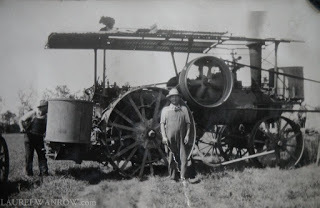
Once there, the all the equipment was unloaded and the sawmill set up again, including digging a pit for the sawdust to fall into, aligning the engine to the sawmill so the belt ran straight between the pulleys, and leaving room for the rails and log carriage.
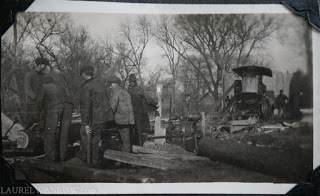
Then, Herb, could remove his coat and get to the business of directing the next set of customers on how to handle the logs while he operated the sawmill’s blade.
Seeing this really drove home the teamwork involved. Herb might have owned the rig, had the willingness to tinker and adjust, the ability to detect when it was working properly, and the skill to use up that cant efficiently, but he couldn’t do the work by himself.
A lot of steam stories seem to be romanticized, making machinery operation sound easy—the heat, fuel needs and labor to run them glossed over. Listening to my dad and aunt tell these memories of their family helped me to imagine many details for my steampunk story and brought up a few realities I wanted to get right.
Steam machinery is big and slow. I realized that once their equipment was out in the field, my farmworkers would not be returning it to the outbuildings each night. I gave them ‘equipment sheds’ in the fields for temporary storage, and even set the shapeshifter hero’s opening scene there, chasing one of the mysterious pests through the spindly legs of the stored clockwork machinery.
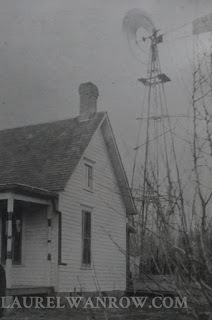
Water and fuel to heat it must be available. I didn’t give this a lot of thought in my early draft. I had boys levering a hand pump to send water to the tank of a two-story tall machine—through a hose. (What was I thinking?) When my aunt mentioned her dad used his parents’ windmill to fill his water sizable water tank, I asked, didn’t your farm have water? Not really, she answered, just a well with a hand pump…and to pump that amount of water by hand was unthinkable. The light dawned: the windmill did the heavy pumping. I immediately put up a windmill on Wellspring Farm (Easy for me say, er, write!) and added a rolling tank to supply the water, via pipes.
Most importantly, I didn’t worry about making all my characters knowledgably about mechanics. In my story, as in real life, not everyone has the same skill set, but everyone’s help is needed.
Herb Wanrow operated his sawmill every winter from the late 1910s to the 1940s. After a couple of seasons, he achieved what he set out to do: he was able to purchase a new car, a 1922 Star Car.
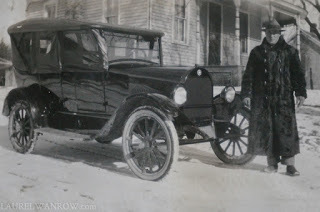
~ ~ ~
Laurel Wanrow has dabbled in genealogy since high school, recording family history tales from both sides of her family, and her husband’s. She’s lucky enough to be caretaker for the Wanrow family cabin in the Rocky Mountains, built by her father and his parents, though the lumber did not come from Herb’s sawmill.

The Unraveling, Volume One of The Luminated Threads is Laurel’s debut novel, a Steampunk Fantasy Romance is set in Victorian England in a rural valley of shapeshifters and magic.

It’s available on Amazon in ebook and print if you’d like to hold that gorgeous cover in your hands. Laurel can be found on Pinterest, Goodreads, Facebook, @laurelwanrow and blogging at www.laurelwanrow.com. To be notified of new releases sign up for Laurel's Newsletter.
Published on July 27, 2015 21:00
Sawmill Story Part 2 by Laura Wanrow
History Undressed would like to welcome back author Laurel Wanrow with Part Two ofLessons from a Family History on Sawmill Operation.
Last week, I introduced my grandfather, Herb Wanrow, and the operation of his steam engine-powered sawmill. To my surprise, according to my aunt, most times Herb would take the sawmill to people.
I’d never heard of a portable sawmill, but understood why Herb moved the operation when she reminded me that back in those times transporting the sawmill was easier than hauling the logs for a building’s worth of lumber to Herb’s farm—and back again! There was one caveat: the location had to have a supply of water. Usually the farmers in the area cut from their timber and dragged the logs with teams of horses or mules to a local water source, then put in a request for Herb to come out.

However, I learned ‘easier’ was relative when my aunt relayed this story. Herb and his fireman would set off in the morning with the steam engine pulling the entire rig: sawmill on its wheeled platform, water tank mounted on iron wheels and a wagon filled with slabs. First, he’d stop at his parents’ windmill to fill the water tank—just as we would begin a car road trip with topping off the gas tank. With the twelve-foot long metal chamber full, they wouldn’t risk running out steam power.
The steam engine was powerful, but slow. Steering wasn’t ‘power steering’ but a chain running from the steering wheel to each front wheel to change directions. At three to four miles per hour, it took them most of the day to drive to one of the places they frequently set up, Lenning’s farm, five miles away.
I started to correct my aunt on this math, but she reminded me they had to stop to stoke the fire, add wood, and add water to the steam engine, which meant unhooking and bringing the water tank around each time. He’d pretty much use up that tank of water. My grandmother knew the route, so would catch them at noon, taking Herb his lunch along the road. He ate as he drove—fried chicken, pickles, bread and pie or cake.

Once there, the all the equipment was unloaded and the sawmill set up again, including digging a pit for the sawdust to fall into, aligning the engine to the sawmill so the belt ran straight between the pulleys, and leaving room for the rails and log carriage.

Then, Herb, could remove his coat and get to the business of directing the next set of customers on how to handle the logs while he operated the sawmill’s blade.
Seeing this really drove home the teamwork involved. Herb might have owned the rig, had the willingness to tinker and adjust, the ability to detect when it was working properly, and the skill to use up that cant efficiently, but he couldn’t do the work by himself.
A lot of steam stories seem to be romanticized, making machinery operation sound easy—the heat, fuel needs and labor to run them glossed over. Listening to my dad and aunt tell these memories of their family helped me to imagine many details for my steampunk story and brought up a few realities I wanted to get right.
Steam machinery is big and slow. I realized that once their equipment was out in the field, my farmworkers would not be returning it to the outbuildings each night. I gave them ‘equipment sheds’ in the fields for temporary storage, and even set the shapeshifter hero’s opening scene there, chasing one of the mysterious pests through the spindly legs of the stored clockwork machinery.(Insert photo of Wanrow farm windmill)Water and fuel to heat it must be available. I didn’t give this a lot of thought in my early draft. I had boys levering a hand pump to send water to the tank of a two-story tall machine—through a hose. (What was I thinking?) When my aunt mentioned her dad used his parents’ windmill to fill his water sizable water tank, I asked, didn’t your farm have water? Not really, she answered, just a well with a hand pump…and to pump that amount of water by hand was unthinkable. The light dawned: the windmill did the heavy pumping. I immediately put up a windmill on Wellspring Farm (Easy for me say, er, write!) and added a rolling tank to supply the water, via pipes.
Most importantly, I didn’t worry about making all my characters knowledgably about mechanics. In my story, as in real life, not everyone has the same skill set, but everyone’s help is needed.
Herb Wanrow operated his sawmill every winter from the late 1910s to the 1940s. After a couple of seasons, he achieved what he set out to do: he was able to purchase a new car, a 1922 Star Car.

~ ~ ~
Laurel Wanrow has dabbled in genealogy since high school, recording family history tales from both sides of her family, and her husband’s. She’s lucky enough to be caretaker for the Wanrow family cabin in the Rocky Mountains, built by her father and his parents, though the lumber did not come from Herb’s sawmill.
The Unraveling, Volume One of The Luminated Threads is Laurel’s debut novel, a Steampunk Fantasy Romance is set in Victorian England in a rural valley of shapeshifters and magic.

It’s available on Amazon in ebook and print if you’d like to hold that gorgeous cover in your hands. Laurel can be found on Pinterest, Goodreads, Facebook, @laurelwanrow and blogging at www.laurelwanrow.com. To be notified of new releases sign up for Laurel's Newsletter.
Last week, I introduced my grandfather, Herb Wanrow, and the operation of his steam engine-powered sawmill. To my surprise, according to my aunt, most times Herb would take the sawmill to people.
I’d never heard of a portable sawmill, but understood why Herb moved the operation when she reminded me that back in those times transporting the sawmill was easier than hauling the logs for a building’s worth of lumber to Herb’s farm—and back again! There was one caveat: the location had to have a supply of water. Usually the farmers in the area cut from their timber and dragged the logs with teams of horses or mules to a local water source, then put in a request for Herb to come out.

However, I learned ‘easier’ was relative when my aunt relayed this story. Herb and his fireman would set off in the morning with the steam engine pulling the entire rig: sawmill on its wheeled platform, water tank mounted on iron wheels and a wagon filled with slabs. First, he’d stop at his parents’ windmill to fill the water tank—just as we would begin a car road trip with topping off the gas tank. With the twelve-foot long metal chamber full, they wouldn’t risk running out steam power.
The steam engine was powerful, but slow. Steering wasn’t ‘power steering’ but a chain running from the steering wheel to each front wheel to change directions. At three to four miles per hour, it took them most of the day to drive to one of the places they frequently set up, Lenning’s farm, five miles away.
I started to correct my aunt on this math, but she reminded me they had to stop to stoke the fire, add wood, and add water to the steam engine, which meant unhooking and bringing the water tank around each time. He’d pretty much use up that tank of water. My grandmother knew the route, so would catch them at noon, taking Herb his lunch along the road. He ate as he drove—fried chicken, pickles, bread and pie or cake.

Once there, the all the equipment was unloaded and the sawmill set up again, including digging a pit for the sawdust to fall into, aligning the engine to the sawmill so the belt ran straight between the pulleys, and leaving room for the rails and log carriage.

Then, Herb, could remove his coat and get to the business of directing the next set of customers on how to handle the logs while he operated the sawmill’s blade.
Seeing this really drove home the teamwork involved. Herb might have owned the rig, had the willingness to tinker and adjust, the ability to detect when it was working properly, and the skill to use up that cant efficiently, but he couldn’t do the work by himself.
A lot of steam stories seem to be romanticized, making machinery operation sound easy—the heat, fuel needs and labor to run them glossed over. Listening to my dad and aunt tell these memories of their family helped me to imagine many details for my steampunk story and brought up a few realities I wanted to get right.
Steam machinery is big and slow. I realized that once their equipment was out in the field, my farmworkers would not be returning it to the outbuildings each night. I gave them ‘equipment sheds’ in the fields for temporary storage, and even set the shapeshifter hero’s opening scene there, chasing one of the mysterious pests through the spindly legs of the stored clockwork machinery.(Insert photo of Wanrow farm windmill)Water and fuel to heat it must be available. I didn’t give this a lot of thought in my early draft. I had boys levering a hand pump to send water to the tank of a two-story tall machine—through a hose. (What was I thinking?) When my aunt mentioned her dad used his parents’ windmill to fill his water sizable water tank, I asked, didn’t your farm have water? Not really, she answered, just a well with a hand pump…and to pump that amount of water by hand was unthinkable. The light dawned: the windmill did the heavy pumping. I immediately put up a windmill on Wellspring Farm (Easy for me say, er, write!) and added a rolling tank to supply the water, via pipes.
Most importantly, I didn’t worry about making all my characters knowledgably about mechanics. In my story, as in real life, not everyone has the same skill set, but everyone’s help is needed.
Herb Wanrow operated his sawmill every winter from the late 1910s to the 1940s. After a couple of seasons, he achieved what he set out to do: he was able to purchase a new car, a 1922 Star Car.

~ ~ ~
Laurel Wanrow has dabbled in genealogy since high school, recording family history tales from both sides of her family, and her husband’s. She’s lucky enough to be caretaker for the Wanrow family cabin in the Rocky Mountains, built by her father and his parents, though the lumber did not come from Herb’s sawmill.

The Unraveling, Volume One of The Luminated Threads is Laurel’s debut novel, a Steampunk Fantasy Romance is set in Victorian England in a rural valley of shapeshifters and magic.

It’s available on Amazon in ebook and print if you’d like to hold that gorgeous cover in your hands. Laurel can be found on Pinterest, Goodreads, Facebook, @laurelwanrow and blogging at www.laurelwanrow.com. To be notified of new releases sign up for Laurel's Newsletter.
Published on July 27, 2015 21:00
July 26, 2015
Video of the Week
Check out this youtube video about the History of the Highland Games!
Published on July 26, 2015 21:00
July 23, 2015
Words in History
Then and Now: Word Definitions
truckthen: goods used for trade in a cash-poor economynow: vehicle meant for haulingwalletthen: knapsack that carried enough provisions for a trip of a few daysnow: small billfold that holds money
negligeethen: dress opened in front to show decorated petticoatnow: woman's light gown made of filmy fabrichumble piethen: pie filled with entrails of deernow: make a shame-filled apologysmugthen: well-dressednow: self-righteous
Erotic Word of the Week
Oral Sextalking turkeygob jobscoffinggummerhead date
truckthen: goods used for trade in a cash-poor economynow: vehicle meant for haulingwalletthen: knapsack that carried enough provisions for a trip of a few daysnow: small billfold that holds money

negligeethen: dress opened in front to show decorated petticoatnow: woman's light gown made of filmy fabrichumble piethen: pie filled with entrails of deernow: make a shame-filled apologysmugthen: well-dressednow: self-righteous
Erotic Word of the Week
Oral Sextalking turkeygob jobscoffinggummerhead date
Published on July 23, 2015 21:00
July 22, 2015
July 20th thru July 26th
What Happened This Week in History?
July 20, 1987- Production was completed on Prince's third movie "Sign O' The Times" in Minneapolis, MNJuly 21, 2007- The seventh and last book of the Harry Potter series, "Harry Potter and the Deathly Hallows" was released July 22, 1376- The legend of the Pied Piper of Hamelin leading rats out of town is said to have occurred on this dateJuly 23, 1829- William Burt patented the typographer, which was the first typewriterJuly 24, 1985- Walt Disney released "The Black Cauldron" making this their twenty-fifth full-length cartoonJuly 25, 1850- Gold was discovered in the Rogue River in OregonJuly 26, 1788- New York became the eleventh State to ratify in the US Constituion
July 22, 1376- The legend of the Pied Piper of Hamelin leading rats out of town is said to have occurred on this dateJuly 23, 1829- William Burt patented the typographer, which was the first typewriterJuly 24, 1985- Walt Disney released "The Black Cauldron" making this their twenty-fifth full-length cartoonJuly 25, 1850- Gold was discovered in the Rogue River in OregonJuly 26, 1788- New York became the eleventh State to ratify in the US Constituion
July 20, 1987- Production was completed on Prince's third movie "Sign O' The Times" in Minneapolis, MNJuly 21, 2007- The seventh and last book of the Harry Potter series, "Harry Potter and the Deathly Hallows" was released
 July 22, 1376- The legend of the Pied Piper of Hamelin leading rats out of town is said to have occurred on this dateJuly 23, 1829- William Burt patented the typographer, which was the first typewriterJuly 24, 1985- Walt Disney released "The Black Cauldron" making this their twenty-fifth full-length cartoonJuly 25, 1850- Gold was discovered in the Rogue River in OregonJuly 26, 1788- New York became the eleventh State to ratify in the US Constituion
July 22, 1376- The legend of the Pied Piper of Hamelin leading rats out of town is said to have occurred on this dateJuly 23, 1829- William Burt patented the typographer, which was the first typewriterJuly 24, 1985- Walt Disney released "The Black Cauldron" making this their twenty-fifth full-length cartoonJuly 25, 1850- Gold was discovered in the Rogue River in OregonJuly 26, 1788- New York became the eleventh State to ratify in the US Constituion
Published on July 22, 2015 21:00



